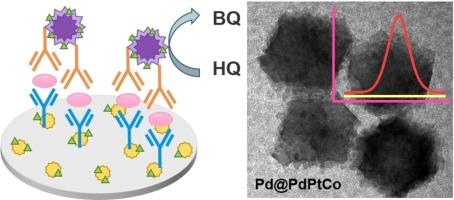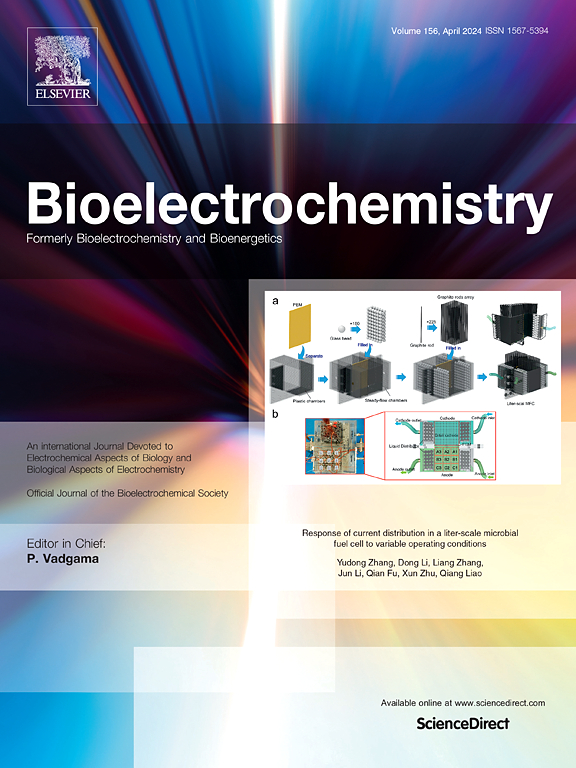A sensitive electrochemical biosensor based on Pd@PdPtCo mesoporous nanopolyhedras as signal amplifiers for assay of cardiac troponin I
IF 4.8
2区 化学
Q1 BIOCHEMISTRY & MOLECULAR BIOLOGY
引用次数: 0
Abstract
Cardiac troponin I (cTnI) has been widely used in clinical diagnosis of acute myocardial infarction (AMI). Herein, a sensitive electrochemical biosensor for cTnI analysis was designed, in which the simple synthesized Pd@PdPtCo mesoporous nanopolyhedras (MNPs) were utilized as signal amplifiers. The mesoporous polyhedral structure of Pd@PdPtCo MNPs endows them with more specific surface area and more active sites, as well as the synergistic effect between multiple metal elements, all of which increase the electrocatalytic performance of Pd@PdPtCo MNPs in efficiently oxidizing hydroquinone (HQ) to benzoquinone (BQ). Experimental results showed that Pd@PdPtCo MNPs had better performance in oxidation of HQ to BQ compared with their corresponding monometallic and bimetallic nanomaterials. With the aid of the interaction between antigens and antibodies, the peak current of HQ to BQ showed an upward trend with increasing concentration of cTnI, thus the quantitative detection of cTnI could be achieved. Under optimal conditions, the biosensor prepared in this work has a wider linear range (1.0 × 10−4–200 ng mL−1) and a lower detection limit (0.031 pg mL−1) than other sensors reported in literatures, coupled by good stability and high sensitivity. More importantly, it also performed well in complex serum environment, proving that the electrochemical sensor has a practical application potential in this field.

基于 Pd@PdPtCo 介孔纳米多面体作为信号放大器的灵敏电化学生物传感器,用于检测心肌肌钙蛋白 I。
心肌肌钙蛋白 I(cTnI)已被广泛应用于急性心肌梗死(AMI)的临床诊断。本文设计了一种用于分析 cTnI 的灵敏电化学生物传感器,利用简单合成的 Pd@PdPtCo 介孔纳米多面体(MNPs)作为信号放大器。Pd@PdPtCo MNPs的介孔多面体结构使其具有更大的比表面积和更多的活性位点,以及多种金属元素之间的协同效应,所有这些都提高了Pd@PdPtCo MNPs高效氧化对苯二酚(HQ)为苯醌(BQ)的电催化性能。实验结果表明,与相应的单金属和双金属纳米材料相比,Pd@PdPtCo MNPs 在将对苯二酚(HQ)氧化为苯醌(BQ)的过程中具有更好的性能。借助抗原与抗体之间的相互作用,HQ 转化为 BQ 的峰值电流随 cTnI 浓度的增加而呈上升趋势,从而实现了 cTnI 的定量检测。在最佳条件下,与其他文献报道的传感器相比,本研究制备的生物传感器具有更宽的线性范围(1.0 × 10-4-200 ng mL-1)和更低的检测限(0.031 pg mL-1),同时还具有良好的稳定性和高灵敏度。更重要的是,它在复杂的血清环境中也有良好的表现,证明该电化学传感器在这一领域具有实际应用潜力。
本文章由计算机程序翻译,如有差异,请以英文原文为准。
求助全文
约1分钟内获得全文
求助全文
来源期刊

Bioelectrochemistry
生物-电化学
CiteScore
9.10
自引率
6.00%
发文量
238
审稿时长
38 days
期刊介绍:
An International Journal Devoted to Electrochemical Aspects of Biology and Biological Aspects of Electrochemistry
Bioelectrochemistry is an international journal devoted to electrochemical principles in biology and biological aspects of electrochemistry. It publishes experimental and theoretical papers dealing with the electrochemical aspects of:
• Electrified interfaces (electric double layers, adsorption, electron transfer, protein electrochemistry, basic principles of biosensors, biosensor interfaces and bio-nanosensor design and construction.
• Electric and magnetic field effects (field-dependent processes, field interactions with molecules, intramolecular field effects, sensory systems for electric and magnetic fields, molecular and cellular mechanisms)
• Bioenergetics and signal transduction (energy conversion, photosynthetic and visual membranes)
• Biomembranes and model membranes (thermodynamics and mechanics, membrane transport, electroporation, fusion and insertion)
• Electrochemical applications in medicine and biotechnology (drug delivery and gene transfer to cells and tissues, iontophoresis, skin electroporation, injury and repair).
• Organization and use of arrays in-vitro and in-vivo, including as part of feedback control.
• Electrochemical interrogation of biofilms as generated by microorganisms and tissue reaction associated with medical implants.
 求助内容:
求助内容: 应助结果提醒方式:
应助结果提醒方式:


